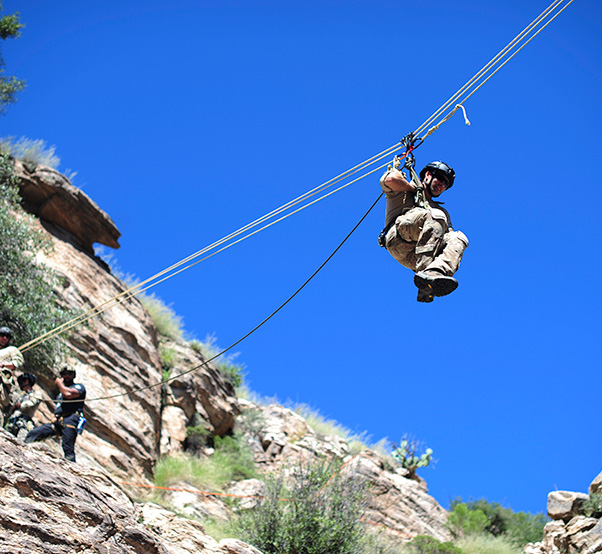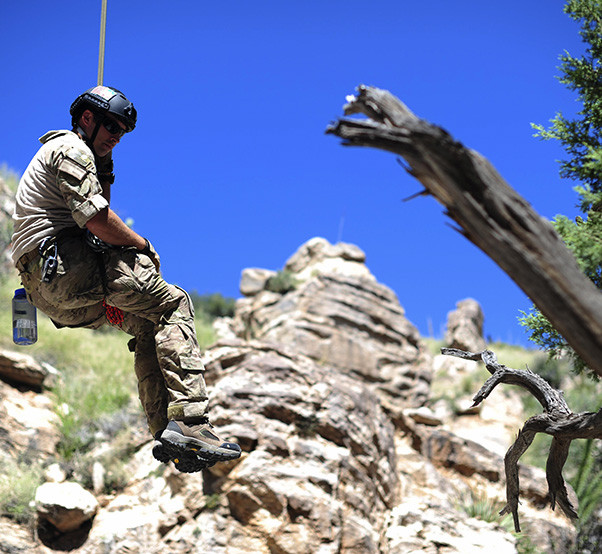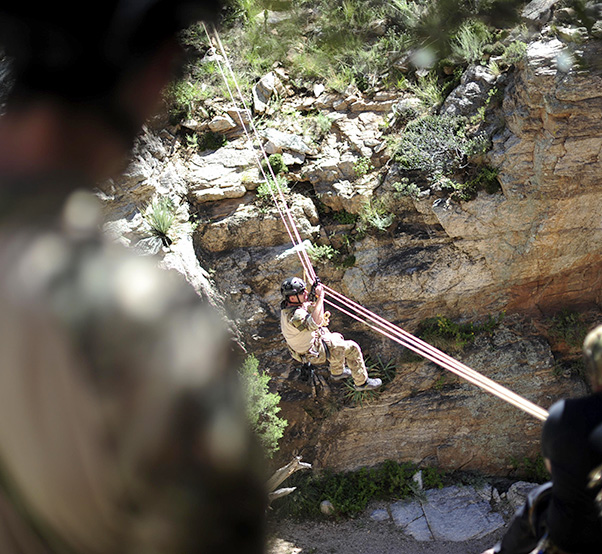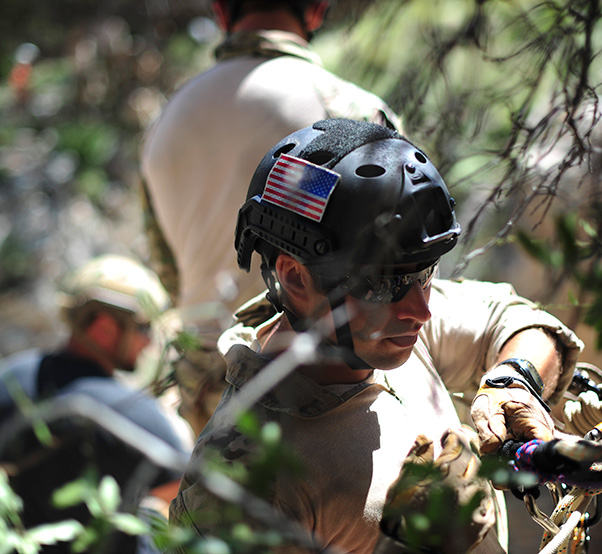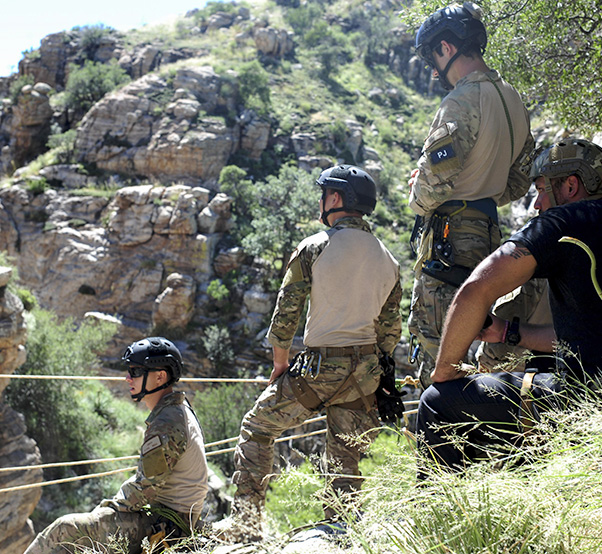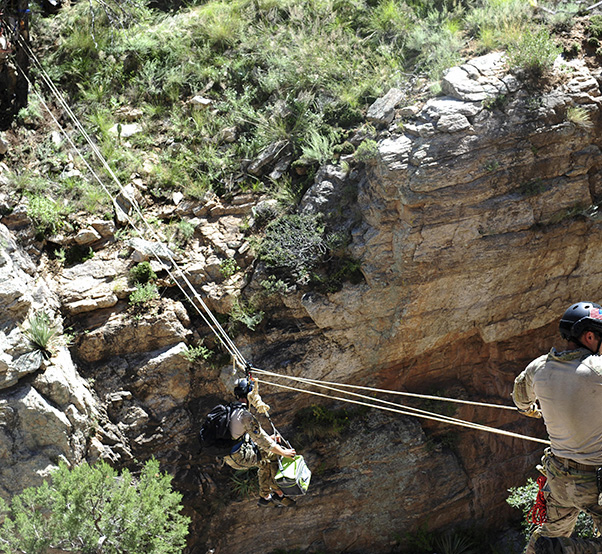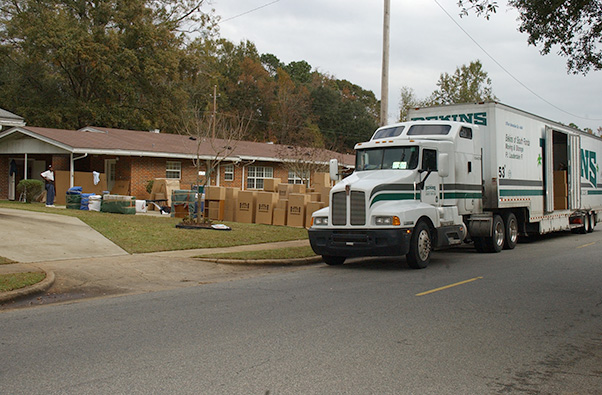A pararescueman from the 48th Rescue Squadron traverses a ravine on a highline at the Coronado National Forest in Tucson, Ariz., Sept. 16, 2016. Airmen from the 48th RQS completed a week of high angle rescue training where they were taught how to use ropes to extract someone who may be trapped at the bottom of a ravine.
Pararescuemen are required to be proficient in a great number of rescue techniques. When they aren’t deployed, they are honing their skills and learning new ones.
The 48th Rescue Squadron recently completed a week of high angle rescue training.
“The culmination of this entire week is being able to get dropped off at one location as a team and move through a mountainous environment,” said 1st Lt. Nick Sola, 48th RQS combat rescue officer. “As well as incorporating the isolated personnel you have rescued.”
The Airmen were taught how to use ropes to extract someone who may be stranded at the bottom of a ravine.
A pararescueman from the 48th Rescue Squadron descends into a ravine from a highline at the Coronado National Forest in Tucson, Ariz., Sept. 16, 2016. The 48th RQS provides highly trained experts capable of quickly and effectively executing personnel recovery operations across the spectrum of conflict.
“It’s part of our annual training plan, which is what we do every year prior to our deployment,” Sola said. “The high angle training block keeps us ready for mountain rescue and recovery.”
These skills are useful not only overseas but in the mountainous regions in the U.S. as well.
“It’s an extremely valuable skill set, not only do we use this when we’re deployed, but also if local agencies need help or manpower, we are available to go out,” Sola said. “Not only can we stay busy while we’re deployed, but while we’re home stateside we still have a mission. It’s awesome being able to rescue someone anyplace, anytime and in any environment.”
Training plays an important role in accomplishing the 48th RQS’s mission of deploying Guardian Angel personnel worldwide to conduct rescue operations in any environment and execute the full range of personnel recovery functions and tasks.
“The basics of being a parararescueman are being a technical rescue expert and having a very strong medical capability,” said a high angle rescue training participant. “The rope rescue is the base of our technical rescue skill.”
A pararescueman from the 48th Rescue Squadron traverses a ravine on a highline at the Coronado National Forest in Tucson, Ariz., Sept. 16, 2016. Airmen from the 48th RQS completed a week of high angle rescue training where they were taught how to use ropes to extract someone who may be stranded at the bottom of a ravine.
A pararescueman from the 48th Rescue Squadron traverses a ravine on a highline at the Coronado National Forest in Tucson, Ariz., Sept. 16, 2016. The 48th RQS deploys Guardian Angel forces worldwide in support of national security objectives and homeland defense.
A pararescueman from the 48th Rescue Squadron ensures the safety of a rope system at the Coronado National Forest in Tucson, Ariz., Sept. 16, 2016. The 48th RQS provides highly trained experts capable of quickly and effectively executing personnel recovery operations across the spectrum of conflict.
Pararescuemen from the 48th Rescue Squadron stand by for a team member to cross a ravine on a highline at the Coronado National Forest in Tucson, Ariz., Sept. 16, 2016. The 48th RQS deploys Guardian Angel forces worldwide in support of national security objectives and homeland defense.
A pararescueman from the 48th Rescue Squadron traverses a ravine on a highline at the Coronado National Forest in Tucson, Ariz., Sept. 16, 2016. The 48th RQS recovery teams have saved hundreds of lives in combat and noncombat situations.







